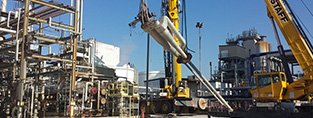
- (03) 5909 8218
- enquiry@fusionweld.com.au
Hydrocracking Units in Petroleum Refineries: What are They?
May 24, 2017

An oil refinery is a little like a chemist's laboratory, except the test tubes and boiling mixes have been enlarged until they straddle massive areas of land. The chemical reactions are also similarly amplified, so the fragile glass beakers are gone. Instead, towering pressure vessels contain the catalysing chemicals. As for hydrocracking units in petroleum refineries, these special catalytic chambers are more active than most refinery units, for there's hydrogen coursing through their innermost workings.
What is Hydrocracking?
A smart engineering student might assume the "hydro" prefix refers to water, but that conjecture is wrong. No, this process uses hydrogen to upgrade "cracked" distillates. In essence, the chambers are formed from several reactor vessels and separators. High temperatures and high pressures break long chained hydrocarbons down in that reactor, so the hostile environment in there requires a robust containment framework. Passed across the hot catalyser, the boiling mixes distill and become unsaturated hydrocarbons. Undoubtedly, these fractions have their place as valuable fuels, but this process is targeting something specific. Enter the hydrogen gas, a simple molecule that further processes the feedstock while controlling the temperature of the various fraction streams. It all sounds complicated, but that chemical complexity pays off in terms of lighter fractions, such as jet fuel and kerosene.
Deconstructing Hydrocracking Mechanisms
Inside the pressurised reactor, the catalysing process is progressing. The hydrocarbon feed and hydrogen are heated, boiled until sulphur and process-contaminating heavy metals are removed. Large molecules are cleaved, lighter fractions break free, and the distillate rises in the distillation tower. Next, the cooling feed flows into a series of separators and fractionators. Pollutants and hydrogen are expelled from the mix, at which point the routed fractions are cooled and condensed. Flash drums and phase separation devices further divide the fractions. There are also numerous supplementary systems in play within the vessels, such as gas recycling scrubbers and water wash systems. In the end, however, the goal is to draw off the valuable fractions, the jet fuels and premier diesel products that were formed through the hydrocracking process.
In engineering terms, this is an extremely hostile internal environment, one that requires fabrication excellence. Top-tier vessel designs endure while corrosive compounds catalyse in high-temperature containment units. Extreme pressure variances exist in here, and the fact that the dangerous processing environment relies on hydrogen as a feedstock separator only underscores this hazard factor. Fortunately, a premier fabrication facility builds this four-part vessel framework with meticulous skill so that the hydrocracking process always functions within design specs.
Contact Details
Fusion - Weld Engineering Pty Ltd
ABN 98 068 987619
1865 Frankston Flinders Road,
Hastings, VIC 3915
Ph: (03) 5909 8218
Optimized by NetwizardSEO.com.au
Recent Posts
- Compressed Hydrogen Storage Vessels: Material Selection, Design & Australian Standards
- Welding QA/QC in Oil & Gas Pressure Vessel Fabrication – Ensuring Code Compliance
- AS1210 vs ASME VIII Pressure Vessel Code: Key Differences for Australian Projects
- Mitigating Hydrogen-Induced Cracking in Pressure Vessels: Engineering and Material Strategies
- Storage Tank Solutions Australia: Field-Erected, Prefabricated & Self-Bunded Explained
- Reducing Environmental Risks: Self-Bunded Tanks in Australian Oil & Gas Operations
- Precision in Production: How Pressure Vessels Are Manufactured for Industrial Safety
- Shell & Tube Heat Exchangers: Improve Thermal Control & Energy Recovery in Petrochemical & Pharmaceutical Plants
- In-Service Inspection for Compressed Air Receivers for Power Plant Shutdown Prevention
- Power Plant Pipe Spooling Fabrication – Get Rapid, Code-Compliant Spools Ready for Installation
- Field Erected Tanks: Safe, Reliable On-Site Fuel Storage Solutions in Australia
- Custom Pressure Vessel Fabrication for Flammable Gases
Posts 2025
- Compressed Hydrogen Storage Vessels: Material Selection, Design & Australian Standards
- Welding QA/QC in Oil & Gas Pressure Vessel Fabrication – Ensuring Code Compliance
- View all articles…
Posts 2024
- Large Process Vessels: Optimising the Design for Maximum Efficiency [2025]
- Pressure Equipment Management System Installation: Detect Equipment Faults Early
- View all articles…
Posts 2023
- Pressure Piping System Inspection: A Gift of Safety for the Holidays
- Deaerator Inspections by Fusion-Weld Engineering and How They Reduce System Downtime
- View all articles…
Posts 2022
- How Fusion Weld Keeps Up With AS-NZS ISO 9001:2008 Standard
- Boiler Equipment Safety Inspection During the Summer Season
- View all articles…
Posts 2021
- Avoid These Factors and Practices that Contribute to Sealing Damage in Pressure Vessels
- Do's And Don'ts Of Industrial Boiler Inspection And Maintenance From Fusion-Weld
- View all articles…
Posts 2020
- What are the Risks and Hazards Involved in Pressure Vessel Equipment?
- How to Know if Your Pressure Equipment Needs Repair or Replacement?
- View all articles…
Posts 2019
- Factors that Contribute to Pressure Vessel Failure
- Pressure Vessel Regulations in Australia: What are the Mandatory Requirements?
- View all articles…
Posts 2018
- Pros and Cons of Spherical vs. Cylindrical Pressure Vessels
- What are the Different Hazard Levels in Pressure Vessels?
- View all articles…
Posts 2017
- Transportable Pressure Vessels: The Importance of Inspection and Safety Checks
- Fracture Mechanics and Stress Analysis of Cracks in Pressure Vessels
- View all articles…
Posts 2016
Posts 2015
- What Are Deaerators & Feedwater Vessels?
- Precautions and Safety for Compressed Air Receiver Vessels
- View all articles…
Posts 2014
- Demonstrating In-process Inspection Procedures
- Static Grounding Practices and Standards
- View all articles…